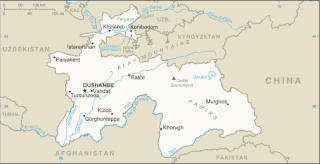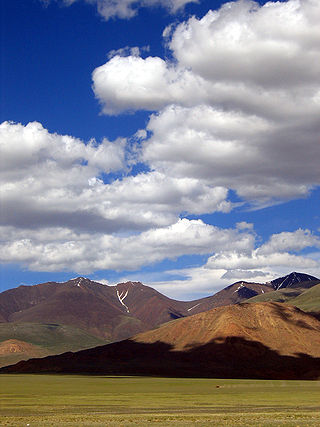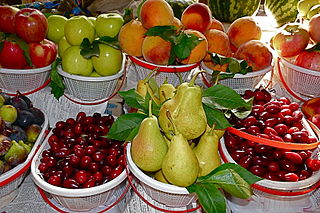
Tajikistan is nestled between Kyrgyzstan and Uzbekistan to the north and west, China to the east, and Afghanistan to the south. Mountains cover 93 percent of Tajikistan's surface area. The two principal ranges, the Pamir Mountains and the Alay Mountains, give rise to many glacier-fed streams and rivers, which have been used to irrigate farmlands since ancient times. Central Asia's other major mountain range, the Tian Shan, skirts northern Tajikistan. Mountainous terrain separates Tajikistan's two population centers, which are in the lowlands of the southern and northern sections of the country. Especially in areas of intensive agricultural and industrial activity, the Soviet Union's natural resource utilization policies left independent Tajikistan with a legacy of environmental problems.

The economy of Tajikistan is dependent upon agriculture and services. Since independence, Tajikistan has gradually followed the path of transition economy, reforming its economic policies. With foreign revenue precariously dependent upon exports of cotton and aluminium, the economy is highly vulnerable to external shocks. Tajikistan's economy also incorporates a massive black market, primarily focused on the drug trade with Afghanistan. Heroin trafficking in Tajikistan is estimated to be equivalent to 30-50% of national GDP as of 2012.

The Tajik Soviet Socialist Republic, also commonly known as Soviet Tajikistan, the Tajik SSR, or simply Tajikistan, was one of the constituent republics of the Soviet Union which existed from 1929 to 1991 located in Central Asia.

Khatlon Region, one of the four provinces of Tajikistan, is the most populous of the four first level administrative regions. It is situated in the southwest of the country, between the Hisor (Gissar) Range in the north and the river Panj in the south and borders on Afghanistan in the southeast and on Uzbekistan in the west. During Soviet times, Khatlon was divided into Kurgan-Tyube (Qurghonteppa) Oblast – with the Kofarnihon and Vakhsh river valleys – and Kulob Oblast – with the Kyzylsu and Yakhsu river valleys. Both regions were merged in November 1992 into today's Khatlon Region. The capital city is Bokhtar, formerly known as Qurghonteppa and Kurgan-Tyube.
Agriculture in Uzbekistan employs 28% of the country's labor force and contributes 24% of its GDP. Crop agriculture requires irrigation and occurs mainly in river valleys and oases. Cultivable land is 4.5 million hectares, or about 10% of Uzbekistan's total area, and it has to be shared between crops and cattle. Desert pastures cover fully 50% of the country, but they support only sheep.

Agriculture in Mongolia constitutes over 10% of Mongolia's annual Gross domestic product and employs one-third of the labor force. However, the high altitude, extreme fluctuation in temperature, long winters, and low precipitation provides limited potential for agricultural development. The growing season is only 95 – 110 days. Because of Mongolia's harsh climate, it is unsuited to most cultivation.
Agriculture in Lithuania dates to the Neolithic period, about 3,000 to 1,000 BC. It has been one of Lithuania's most important occupations for many centuries.

Agriculture is considered the backbone of Pakistan's economy, which relies heavily on its major crops. Pakistan's principal natural resources are arable land and water. Agriculture accounts for about 18.9% of Pakistan's GDP and employs about 42.3% of the labour force. The most agricultural province is Punjab where wheat & cotton are the most grown. Mango orchards are mostly found in Sindh and Punjab provinces, making it the world's fourth largest producer of mangoes.

Agriculture in Ethiopia is the foundation of the country's economy, accounting for half of gross domestic product (GDP), 83.9% of exports, and 80% of total employment.

Agriculture in Sudan plays an important role in that country's economy. Agriculture and livestock raising are the main sources of livelihood for most of the Sudanese population. It was estimated that, as of 2011, 80 percent of the labor force were employed in that sector, including 84 percent of the women and 64 percent of the men.

Armenia has 2.1 million hectares of agricultural land, 72% of the country's land area. Most of this, however, is mountain pastures, and cultivable land is 480,000 hectares, or 16% of the country's area. In 2006, 46% of the work force was employed in agriculture, and agriculture contributed 21% of the country's GDP. In 1991 Armenia imported about 65 percent of its food.

The role of agriculture in the Bolivian economy in the late 1980s expanded as the collapse of the tin industry forced the country to diversify its productive and export base. Agricultural production as a share of GDP was approximately 23 percent in 1987, compared with 30 percent in 1960 and a low of just under 17 percent in 1979. The recession of the 1980s, along with unfavorable weather conditions, particularly droughts and floods, hampered output. Agriculture employed about 46 percent of the country's labor force in 1987. Most production, with the exception of coca, focused on the domestic market and self-sufficiency in food. Agricultural exports accounted for only about 15 percent of total exports in the late 1980s, depending on weather conditions and commodity prices for agricultural goods, hydrocarbons, and minerals.

Agriculture in Jordan contributed substantially to the economy at the time of Jordan's independence, but it subsequently suffered a decades-long steady decline. In the early 1950s, agriculture constituted almost 40 percent of GNP; on the eve of the Six-Day War, it was 17 percent.

Agriculture in Cyprus constituted the backbone of its economy when it achieved its independence in 1960. It mostly consisted of small farms, and sometimes even subsistence farms. During the 1960s, irrigation projects made possible vegetable and fruit exports; increasingly commercialized farming was able to meet the demands for meat, dairy products, and wine from the British and United Nations troops stationed on the island and from the growing number of tourists.
Prior to World War II, agriculture in Bulgaria was the leading sector in the Bulgarian economy. In 1939, agriculture contributed 65 percent of Net material product (NMP), and four out of every five Bulgarians were employed in agriculture. The importance and organization of Bulgarian agriculture changed drastically after the war, however. By 1958, the Bulgarian Communist Party (BCP) had collectivized a high percentage of Bulgarian farms; in the next three decades, the state used various forms of organization to improve productivity, but none succeeded. Meanwhile, private plots remained productive and often alleviated agricultural shortages during the Todor Zhivkov era.
In 2018, Latvia produced 1.4 million tons of wheat; 426 thousand tons of potato; 306 thousand tons of barley; 229 thousand tons of rapeseed; 188 thousand tons of oat; 81 thousand tons of rye; 80 thousand tons of bean; and smaller quantities of other agricultural products.
Despite the crisis in Syria, agriculture remains a key part of the economy. The sector still accounts for an estimated 26 percent of gross domestic product (GDP) and represents a critical safety net for the 6.7 million Syrians – including those internally displaced - who still remain in rural areas. However, agriculture and the livelihoods that depend on it have suffered massive losses . Today, food production is at a record low and around half the population remaining in Syria are unable to meet their daily food needs.

Moldova is an agrarian-industrial state, with agricultural land occupying 2,499,000 hectares in a total area of 3,384,600 hectares. It is estimated that 1,810,500 of these hectares are arable. Moldova is located in Eastern Europe, and is landlocked, bordering Romania and Ukraine. Moldova's agricultural sector benefits from a geographical proximity to large markets, namely the European Union. As a share of GDP, agriculture has declined from 56% in 1995 to 13.8% in 2013. Data from 2015 estimated that agriculture accounted for 12% of Moldova's GDP. Agriculture as a sector is export-oriented, with the composition of Moldova's total exports containing agriculture and the agri-food sector as a main component. 70% of agri-food exports in 2012 included beverages, edible fruits and nuts, oilseeds, vegetable preparations and cereals. Here, fruits, vegetables and nuts were attributed to 33% of Moldova's exports for 2011–2013. Moldova is also one of the top ten apple exporters in the world. However, because of the long-term emphasis on fruit, vegetables are often imported.
Mozambique has a variety of regional cropping patterns; agro-climatic zones range from arid and semi-arid to the sub-humid zones to the humid highlands. The most fertile areas are in the northern and central provinces, which have high agro-ecological potential and generally produce agricultural surpluses. Southern provinces have poorer soils and scarce rainfall, and are subject to recurrent droughts and floods.

Agriculture in the Republic of North Macedonia provides a livelihood for a fifth of the country's population, where half live in a rural area. Industrialisation of the country was very delayed, due to the long Ottoman domination, and then destruction from World War 1 and Serbian occupation. Massive agrarian reforms began under Socialist Federative Yugoslavia with its own communist rule. The continental and sub-Mediterranean climates in the country allows for a great diversity of output, but the pronounced terrain creates areas that are unexploitable for farmers. Macedonian agriculture is dominated by livestock farming, especially in its mountainous regions, viticulture, and the growing of fruit and vegetables, cereals, and tobacco. Agriculture in the country is characterised by numerous small-scale family farms, but also by large businesses, left over from the socialist era. Since its independence in 1991, the country has become a market economy. Today, agriculture accounts for 10% of North Macedonia's GDP.














